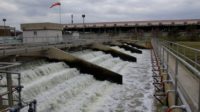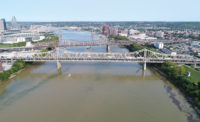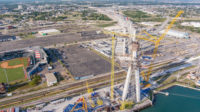The unified command tasked to respond to the Francis Scott Key Bridge collapse in Baltimore said March 29 it has begun an engineering assessment for efforts to move the container ship Dali and bridge wreckage. But officials warned progress may be slow, as the Patapsco River and Port of Baltimore remain closed to shipping traffic.
One of the massive cranes removing the wreckage of the Francis Scott Key Bridge has a long and colorful history starting with a Cold War nuclear sub recovery. In 2017, ENR’s Nadine Post penned a detailed article on the Chesapeake 1000 crane.
See the article!
Maryland Gov. Wes Moore told reporters that the U.S. Navy is supplying four heavy lift cranes for the effort. Two were already on-scene, and a third was scheduled to arrive that night. The final heavy lift crane is expected on April 1. Officials expect to have a total of seven floating cranes, 10 tugs, nine barges and five Coast Guard boats involved in the work.
One crane barge already on site—the Chesapeake 1,000 owned by Donjon Marine Co. Inc. of Hillside, N.J.—has a 1,000-ton lift capacity. But officials believe the piece of the bridge resting on the Dali weighs three or four times that much, so it will need to be cut into smaller pieces, he said.
“To see this up close, you realize how daunting a task this is,” Moore said. “You realize how difficult the work is ahead of us.”
It will take some time before the unified command can remove the remains of the fallen bridge. The engineering assessment includes wreckage both above and below the water line, Rear Adm. Shannon Gilreath, commander of the Fifth Coast Guard District, said during a press conference. He said the unified command includes engineers from the U.S. Army Corps of Engineers, Navy Supervisor of Salvage, state, private firms and the U.S. Coast Guard. The engineering firms involved include Resolve Marine, Donjon-Smit and Skanska, a spokesperson for the unified command told ENR.
“They’re all working diligently to figure out that plan to be able to break that bridge up into the right-sized pieces that we can lift,” Gilreath said.
The process will involve repeated lifts and reassessments to ensure stability, said Col. Estee Pinchasin, commander of the Corps Baltimore District, during a press conference. She said it’s a methodical process that may appear slow to onlookers but will ultimately hasten efforts to clear the channel and reopen the port. It is too early to provide a timeline for the work, she added.
“By investing this time now in the engineering, we’re going to be able to move faster later,” Pinchasin said.
Many of the people working on this effort were also part of the team that refloated the container ship Ever Given in 2022 after it ran aground in the Chesapeake Bay shallows, Pinchasin said.
“That industry muscle memory, that incredible wealth of knowledge, expertise, skills, experience—all those lessons are being applied here,” she said.
Once the wreckage is cleared, officials also aim to build a replacement bridge. The U.S. Dept. of Transportation Federal Highway Administration announced that it made $60 million in “quick release” emergency funds available on March 28 for rebuilding. U.S. Transportation Secretary Pete Buttigieg said the agency would continue to provide additional resources to support rebuilding.
In the meantime, Moore said Tradepoint Atlantic, a multi-modal marine terminal located down river from the former bridge, has been able to accept some cargo that had been bound for the Port of Baltimore.
Four construction workers who had been on the bridge when the Dali collided with it early March 26 are still missing and presumed to be dead. The bodies of two other workers have been recovered. Moore said finding the rest remains a priority, although conditions in the river have hindered divers’ ability to search the area.






Post a comment to this article
Report Abusive Comment